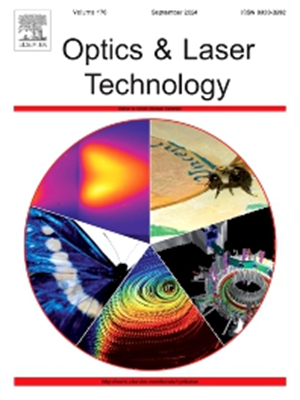低温激光辅助切割SiCp/Al复合材料的材料去除机理
IF 5
2区 物理与天体物理
Q1 OPTICS
引用次数: 0
摘要
铝基碳化硅(SiCp/Al)由于其优异的力学性能,被广泛用于光学系统的机械结构部件的制造。然而,由于软Al基和硬sic增强颗粒之间材料性能的显著差异,实现SiCp/Al复合材料的超光滑表面仍然是一个挑战。为了提高SiCp/Al复合材料的可加工性,提出了一种低温处理与激光加热相结合的新型切削方法。纳米压痕测试表明,低温处理显著提高了SiCp/Al复合材料的硬度约46.4%(从室温下的约6.55 GPa提高到233 K时的约9.599 GPa),杨氏模量提高约20%。然后对SiCp/Al进行坡口切削,研究其韧性切削性能。结果表明,低温激光辅助切割(CLAC)以较低的切削力获得了高质量的表面,而普通切割、低温辅助切割和激光辅助切割(LAC)则产生了各种缺陷。这些结果表明,CLAC提高了表面质量,为高精度制造SiCp/Al复合材料提供了潜在的解决方案。最后,通过分子动力学模拟来解释CLAC过程中材料的去除机理。模拟结果表明,低温辅助可以增强SiC颗粒与Al基体之间的界面结合,从而抑制SiC颗粒的脱粘。本文章由计算机程序翻译,如有差异,请以英文原文为准。
Material removal mechanism of cryogenic-laser assisted cutting for SiCp/Al composites
Aluminium-based silicon carbide (SiCp/Al) is widely used for the fabrication of mechanical structural components of optical systems, due to its excellent mechanical properties. However, owing to the significant differences in material properties between the soft Al matrix and hard SiC-reinforced particles, achieving an ultra-smooth surface of SiCp/Al composites remains challenging. In this study, a novel cutting approach combining cryogenic treatment with laser heating is proposed to improve the machinability of SiCp/Al composites. Nanoindentation tests reveal that low-temperature treatment significantly increased the hardness of SiCp/Al composite materials by approximately 46.4 % (from approximately 6.55 GPa at room temperature to approximately 9.599 GPa at 233 K), and increased the Young’s modulus by approximately 20 %. Then, groove cutting was conducted to investigate the ductile machinability of SiCp/Al. The results showed that Cryogenic-Laser Assisted Cutting (CLAC) achieves high-quality surface with lower cutting force, whereas ordinary cutting, cryogen-assisted cutting, and Laser Assisted Cutting (LAC) resulted in various defects. These results suggest that CLAC enhances the surface quality, offering a potential solution for high-precision manufacturing of SiCp/Al composites. Finally, molecular dynamics simulations were performed to explain the material removal mechanism during CLAC. The simulation results reveal that low-temperature assistance can enhance the interfacial bonding between SiC particles and the Al matrix, thereby suppressing the debonding of SiC particles.
求助全文
通过发布文献求助,成功后即可免费获取论文全文。
去求助
来源期刊
CiteScore
8.50
自引率
10.00%
发文量
1060
审稿时长
3.4 months
期刊介绍:
Optics & Laser Technology aims to provide a vehicle for the publication of a broad range of high quality research and review papers in those fields of scientific and engineering research appertaining to the development and application of the technology of optics and lasers. Papers describing original work in these areas are submitted to rigorous refereeing prior to acceptance for publication.
The scope of Optics & Laser Technology encompasses, but is not restricted to, the following areas:
•development in all types of lasers
•developments in optoelectronic devices and photonics
•developments in new photonics and optical concepts
•developments in conventional optics, optical instruments and components
•techniques of optical metrology, including interferometry and optical fibre sensors
•LIDAR and other non-contact optical measurement techniques, including optical methods in heat and fluid flow
•applications of lasers to materials processing, optical NDT display (including holography) and optical communication
•research and development in the field of laser safety including studies of hazards resulting from the applications of lasers (laser safety, hazards of laser fume)
•developments in optical computing and optical information processing
•developments in new optical materials
•developments in new optical characterization methods and techniques
•developments in quantum optics
•developments in light assisted micro and nanofabrication methods and techniques
•developments in nanophotonics and biophotonics
•developments in imaging processing and systems

 求助内容:
求助内容: 应助结果提醒方式:
应助结果提醒方式:


